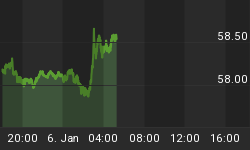During 2001-2007 there were some hefty downward corrections in the gold sector, but although these corrections seemed dramatic in real time they didn't come close to matching either of the primary corrections that occurred during the bull market in gold stocks that began in the early 1960s and ended in 1980. However, the 2008 downturn was every bit as severe as the primary corrections of 1960-1980.
The following long-term weekly chart of the Barrons Gold Mining Index (BGMI) shows how last year's crash fits into the grand scheme of things (the red line on the chart is the 200-week moving average). It is clear from this chart that the 2008 debacle was the bull market's first primary correction and was therefore unlikely to have marked the end of the bull market (long-term bull markets usually have more than one primary correction). Furthermore, in terms of overall magnitude it was not materially worse than the corrections of 1968-1970 or 1974-1976, although it was compressed into a shorter period.

The financial world is NOT following the 1970s pattern. This means that the specific factors that are now causing the long-term decline in monetary confidence, which, in turn, is leading to increasing investment demand for gold-related investments, are not the same as the factors that led to increasing investment demand for gold-related investments during the preceding long-term gold bull market. But even though the financial backdrop is different it may be reasonable to use the previous bull market as a model because bull markets tend to progress along similar lines even if they have different drivers.
If we assume that the 1960s-1970s performance can be used as a guideline then we should expect the initial intermediate-term advance following the primary correction low (the Oct-2008 low) to do no more than take the BGMI back to the vicinity of its 200-week moving average. This had been accomplished at the May-June peak. We should now expect choppy action over much of the next year, with a major advance getting underway in October of 2010 or thereabouts (2 years after the primary correction low).
The above is one possibility. Another is that because the present economic and political situations have more in common with the early 1930s than the early 1970s, we should use, as our template, the gold sector's performance following the 1929 stock market crash.
The following chart from the excellent Sharelynx.com web site compares the stock price of Homestake Mining (HM) with the Dow Industrials Index from the beginning of 1929 through to the end of 1937. HM was the premier North American gold mining company at that time and is the best available proxy for the gold sector's performance during the Great Depression.
Notice that HM was essentially flat during the year after the crash, but began to trend upward in early 1931. Furthermore, notice that its upward trend accelerated shortly after the Dow reached its ultimate low.

We've been saying since November of last year that a new 4-5 year cyclical bull market in gold stocks is probably underway. However, regardless of whether we use the 1970s or the 1930s as our model we should not expect the best part of this new bull market to begin until at least the first half of next year.
We aren't offering a free trial subscription at this time, but free samples of our work (excerpts from our regular commentaries) can be viewed at: http://www.speculative-investor.com/new/freesamples.html.
















